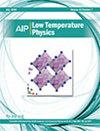Comparative study on the effect of substrates on electrical properties of tin and chromium thin films
IF 0.8
4区 物理与天体物理
Q4 PHYSICS, APPLIED
引用次数: 0
Abstract
In thin film technology, substrate materials happen to be one of the deposition parameters that determine the physical properties of films. Hence, soda-lime glass and quartz continue to be the widely utilized substrate materials because of their high-frequency performance, price, and surface quality. For certain applications, various substrate materials that provide an acceptable compromise for the work at hand are required. Soda-lime glass and quartz have been chosen as the substrates for the tin and chromium thin films that will be produced via thermal evaporation in a vacuum. A comparative study on the electrical properties of chromium films was made in the light of Fuchs–Sondheimer and Mayadas–Shatzkes theories. Numerous physical properties, including resistivity of infinitely thick film, sticking coefficient, conduction electron mean free, etc., may be determined from resistivity-thickness data.基底对锡和铬薄膜电气性能影响的比较研究
在薄膜技术中,基底材料是决定薄膜物理特性的沉积参数之一。因此,钠钙玻璃和石英因其高频性能、价格和表面质量,仍然是广泛使用的基底材料。在某些应用中,需要各种基底材料为手头的工作提供可接受的折衷方案。钠钙玻璃和石英被选为锡和铬薄膜的基底材料,这些薄膜将在真空中通过热蒸发法生产。根据 Fuchs-Sondheimer 和 Mayadas-Shatzkes 理论,对铬薄膜的电特性进行了比较研究。许多物理特性,包括无限厚薄膜的电阻率、粘滞系数、传导电子平均自由度等,都可以从电阻率-厚度数据中确定。
本文章由计算机程序翻译,如有差异,请以英文原文为准。
求助全文
约1分钟内获得全文
求助全文
来源期刊

Low Temperature Physics
物理-物理:应用
CiteScore
1.20
自引率
25.00%
发文量
138
审稿时长
3 months
期刊介绍:
Guided by an international editorial board, Low Temperature Physics (LTP) communicates the results of important experimental and theoretical studies conducted at low temperatures. LTP offers key work in such areas as superconductivity, magnetism, lattice dynamics, quantum liquids and crystals, cryocrystals, low-dimensional and disordered systems, electronic properties of normal metals and alloys, and critical phenomena. The journal publishes original articles on new experimental and theoretical results as well as review articles, brief communications, memoirs, and biographies.
Low Temperature Physics, a translation of the copyrighted Journal FIZIKA NIZKIKH TEMPERATUR, is a monthly journal containing English reports of current research in the field of the low temperature physics. The translation began with the 1975 issues. One volume is published annually beginning with the January issues.
 求助内容:
求助内容: 应助结果提醒方式:
应助结果提醒方式:


